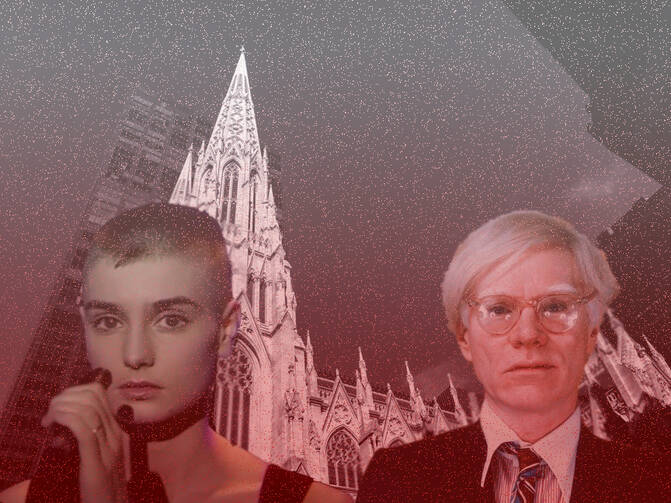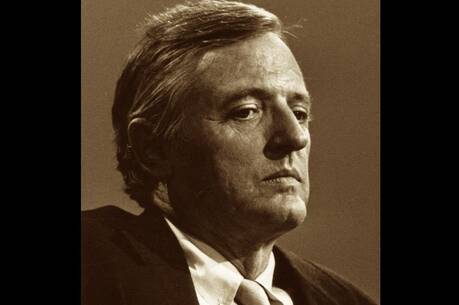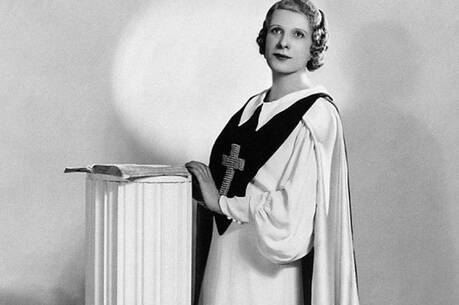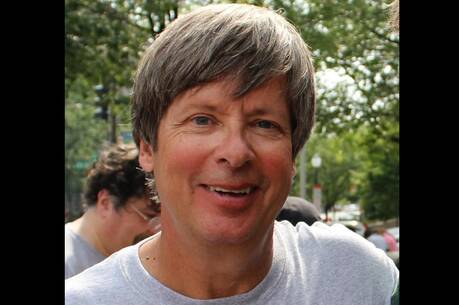Review: The Catholic fragments of art, faith and sex in 1980s pop culture
Not to judge a book by its cover, but Paul Elie’s new one serves as a sterling representative for the story within. A photograph depicts a group of protesters, members of the gay Catholic group Dignity, forming a human cross on Fifth Avenue in New York City in front of St. Patrick’s Cathedral, “America’s parish church,” in 1988, commemorating the first anniversary of the group's ouster from the Jesuit church of St. Francis Xavier in Manhattan. The action occurred in the context of a politically charged decade in which members of the ACT UP movement also engaged in demonstrations in front of the cathedral in protest of Cardinal John O'Connor's statements on condoms, homosexuality and sex education.
The protestors occupy the foreground; the church looms in the background. The cathedral is not immediately identifiable as such: While not the focus of the photograph, it is the center of the demonstrators’ attention—their antagonist. Washed in red—the color of blood and passion, war and martyrdom—the photograph could be a Warhol print: a reproduction of documentary footage transformed into a strange icon of a strained moment.
Between its covers, The Last Supper: Art, Faith, Sex and Controversy investigates pop culture’s crypto-religious, uncanny symbols of immanence and transcendence. In some ways, it reads like a sequel to Elie’s The Life You Save May Be Your Own, in which he stitched together the lives of four great American Catholics—Dorothy Day, Thomas Merton, Walker Percy and Flannery O’Connor—into a portrait of a common pilgrimage through American mid-century religious letters and culture.
The Last Supper is a less cohesive, more fragmented book than Elie’s 2003 classic. It opens in New York City, the melting pot of the various fragments of global culture, and it closes in New York City. In the 400-odd pages in between, the roving narrator takes us around the Northern Hemisphere from Manchester’s homegrown Morrissey and the Smiths to Leonard Cohen in Montreal.
Fragmentation, however, is Elie’s theme. His montage of the 1980s examines variations on an icon, orphaned jigsaw puzzle pieces of symbology lingering in the cultural junk drawer from a discarded religious cosmos: Jean-Michel Basquiat’s crown of thorns, Bono’s white flag from U2’s “War”tour and the titular image, Leonardo da Vinci’s “Last Supper,” which Andy Warhol rendered into more than 100 silk-screen prints and collages for a gallery in Milan.
A more active fragmenting serves as one of the narrative’s bookends—the one where the chart-topping Irish pop singer Sinead O’Connor rips a portrait of Pope John Paul II in half on a “Saturday Night Live” broadcast on Oct. 3, 1992. Pop culture—like, perhaps religious belief—entails embracing icons that need no definition. But pop culture’s icons have an expiration date, one-hit wonders their memento mori.
Some may argue that religion has a shelf life as well. But Elie’s book seeks to demonstrate just how consistently slanted toward the “crypto-religious” and mystic the American public imaginary has been, even throughout “secular” postmodernity, even by the most rebellious of its rebels for artistic causes. Despite our rational, scientific progress, we are drawn to the uncanny, that which lacks explanation. Such phenomena are frequently explored in art, particularly art that refuses to smooth the jagged edges of experience or force the broken fragments into an artificial shape, art that embraces uncertainty, discomfort—controversy.
Frequently, as Elie writes, Catholic and Christian clerics condemned “controversial” pieces of art, sight unseen. “Don’t look at that,” religious leaders said of Madonna’s music videos, Martin Scorsese’s “The Last Temptation of Christ,” Salman Rushdie’s The Satanic Verses, blindly leading the blinded. Where our gaze rests is a moral question.
“What exactly am I supposed to be looking at?” I wondered this at points during The Last Supper’s associative acid trip across genre, country and controversy after controversy. But that question might be a result of a good literary trip. What exactly are we all looking at in post-modernity?
In the proliferation of images on the internet, the fragmentation of thought on Twitter-now-X, what are we supposed to be looking at? Are we in Dublin or Los Angeles or New York City? In a world of one wide web, what’s the difference anymore? What comes of a culture when we’re all looking in different directions, the ideological and social compasses no longer pointing to a common true north? Is there a “we” looking anywhere or just a gaggle of individual voyeurs?
The 1980s serve as Elie’s excavation site of choice because they are the origin point, he argues, of the controversies fracturing into “the culture wars.” He identifies the shift from actual war to war over sex in the years between the condemnation of nuclear weapons by the U.S. Conference of Catholic Bishops in its 1983 pastoral letter “The Challenge of Peace: God’s Promise and Our Response” and the 1986 instruction from the Vatican declaring homosexuality objectively disordered.
Elie’s subtitle promises “Art, Faith, Sex and Controversy,” and so it is in keeping with his vision to focus on the controversies surrounding sex and religion. At points, however, I yearned for the author to look under the hood at some of the other vectors of violence within which art was made and culture was constructed during the “outrageous eighties”—including the runaway incarceration and suburbanization of the country.
The prison population of the United States doubled between 1970 and 1980, then continued to grow at an average of 8 percent each year between 1985 and 1995. Incarceration can be a fragmenting of the human person. Multiple medical studies have shown that incarceration causes anxiety, panic attacks and a breakdown of the social contract. A recent report by the Bureau of Justice Statistics found that 82 percent of previously incarcerated individuals were imprisoned again within 10 years after release. The previously incarcerated also have significantly higher rates of post-traumatic stress disorder after their incarceration is over. P.T.S.D. was formally added to the D.S.M., the Diagnostic and Statistical Manual of Mental Disorders, in 1980.
As the American psyche was fracturing, the lived communities of American society were also fragmenting. Between 1950 and 1970, the suburban population in the United States nearly doubled, to 74 million, with 83 percent of all population growth occurring in suburban places. The 1970 census recorded more Americans living in the suburbs than anywhere else for the first time in the nation’s history.
The suburbs offer neither the dense urban resource-sharing of the cities nor the expansive resource-creation of farms. Suburbs are predicated on the sundering of natural ties with creation (seen in the Stepfordian uniformity of grass-filled yards) and with one’s neighbors (in the proverbial picket fence), and in the suburbs’ tarnished history as an innovation of white flight from cities flooded with Black Americans traveling north in the Great Migration.
Neighbor and creation are two of the key loci not only for finding God in the world, but for making art to begin with. Since the psalmist first strummed his lyre, the lion’s share of poetic reflection is on the creaturely world and the mystery of our own identity within it.
Could the gaps that the suburbs create between neighbors foster room for violence to thrive? Could the estrangement from the natural world, from the natural rhythms of abundance, work, want and need that have marked human society since Homo sapiens began cultivating the land 12,000 years ago create a lacuna in our vision of human nature, setting the stage for endless arguments over anthropology—from debates over gay marriage to gender ideology?
Elie gestures to rapid technological changes in his epilogue: “subway tokens and pay phones and smoky cash-only bars” that have all gone the way of the dodo, hunted to extinction by the machines of our new “frictionless” digital age. Perhaps this technological acceleration, and the economic conditions that contribute to it and are manufactured by it, also contribute to an increasingly violent rhetoric and our collective cultural religiosity, or lack thereof.
In his epilogue, Elie revisits Sinead O’Connor ripping up the pope’s portrait. To many younger Americans, part of a generation whose experience of religion has been so completely defined by the abuse scandals of 2002, 2018 and 2019, O’Connor’s gesture does not seem in the least bit shocking. Ripping up an image of a pope seems like a justified response to the rage and anger that many Catholics feel toward the hierarchy, who have, in one measure or another, broken the body of Christ and betrayed their calling to be shepherds of Christ’s sheep. There are some symbols that have become tainted, their ability to transmit the grace they claim more compromised.
Artists are the antennae for their race, said Ezra Pound, and perhaps by catching their disparate signals, one can make a portrait of the moment, as Elie tries to do. Looking at what the artists are painting, the filmmakers filming and the musicians playing is perhaps as good a place as any to answer the question of what we are looking at.
If the American pilgrimage is a journey away from the cohesive religious cultural vision of the interwar and postwar years that Elie chronicles in The Life You Save May Be Your Own, the 1980s perhaps was a rebellion against a religious Weltanschauung that provided no healing for the physical violence and psychic pain that many artists Elie names experienced in their religious upbringing—O’Connor not least of them.
To return to Elie’s cover: The pathos of the scene may be in the protestors fighting for visibility in a time where H.I.V. and AIDS were decimating the gay community. But Elie’s book focuses the camera lens on where they are lying and who they are addressing: the seemingly impenetrable white marble of the cathedral. In another protest at the cathedral by members of ACT UP, at least one protestor received the Eucharistic host and crumbled it into pieces—an act of desecration that earned them extreme notoriety. Elie presents such demonstrations as the climax of an increasingly violent decade, in which political religious rhetoric opened the church door to a response of political protest.
Yet in a culture defined by the “rise of the nones,” having a common religious tradition to rebel against—a cathedral that means something, against which to protest, from which you expect something—seems like a rich cultural legacy indeed.
The closing words of Elie’s epilogue offer an apologia for art that delves into the depth of religious experience, that takes up the symbols of religion for cultural consideration—a sort of From Union Square to Rome for the Dimes Square set. If everyone from Bono to the Doors can reference the “Gloria,” even profanely, perhaps the common ties that bind us become just that much thicker, richer, wider. Perhaps, then, acts of popular culture can become truly more like a liturgy—the work of a people, not just individuals.
Correction: An earlier version of this article incorrectly stated that the cover image of The Last Supper depicts a group of protestors in the ACT UP movement staging a "die-in" in front of St. Patrick's Cathedral in 1989. The cover image is of a 1988 protest in front of the cathedral by members of the gay Catholic group Dignity.
This article also appeared in print, under the headline “Cultural Fragments,” in the July/August 2025, issue.










